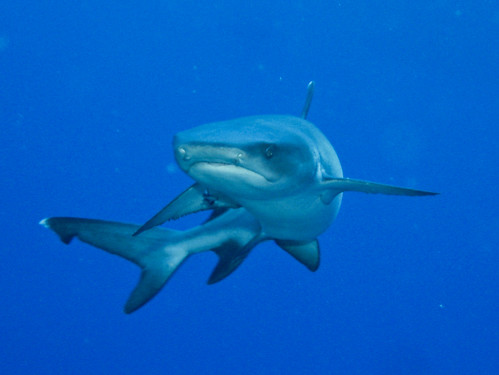 Oceanic whitetip sharks return home to protected Bahamas waters, surprising scientists.
Previously thought to be wide-ranging animals, a tagging survey has revealed that the sharks frequently revisit the same areas around the island.
Conservationists have listed the sharks as Vulnerable globally and Critically Endangered in parts of their range.
Oceanic whitetip sharks return home to protected Bahamas waters, surprising scientists.
Previously thought to be wide-ranging animals, a tagging survey has revealed that the sharks frequently revisit the same areas around the island.
Conservationists have listed the sharks as Vulnerable globally and Critically Endangered in parts of their range.Experts suggest that the island nation's marine protected area is assisting the species.
The findings are published in the online journal PLoS One.
Oceanic whitetips are named for the distinctive white flashes at the end of their fins.
They are opportunistic predators with powerful jaws and as such are considered one of the more dangerous sharks to humans, although the number of unprovoked attacks on people is small.
"Of all the sharks that live in the open ocean they're the ones that have really declined a lot in the last few decades," said Dr Demian Chapman of Stony Brook University, New York, US, who led the study.
"They've gone from being one of the most abundant large vertebrates on the planet to being considered quite endangered."
The International Union for the Conservation of Nature has listed the sharks as Vulnerable due to over-fishing for their meat and leather, and accidental by-catch.
"Oceanic whitetips frequently take bait meant for other species like tuna and swordfish," said Dr Chapman, explaining that their fins are prized for shark fin soup.
"Fisherman will take all of these sharks that were incidentally hooked and they will take their fins, and that is fatal to the shark."
In July 2011, the Bahamian government banned shark fishing in all 240,000 square miles of the country's waters.
According to the Pew Charitable Trusts which works to establish shark sanctuaries, including the one in the Bahamas, the animals provided $78 million to the country's economy in tourism over 20 years.
"Tourism is a big part of the Bahamian economy, within that diving and shark diving in particular is very valuable," said Liz Karan, manager of Global Shark Conservation at Pew.
"I think there's interest in that particular area just because it's one of the few places left in the world that have relatively healthy shark populations."
"So without too much effort you can go and have an experience that's really unique."
In May of the same year, advocates assembled to support the sanctuary announcement.
Dr Chapman joined forces with these dive tour operators, recreational fishermen, scientists, engineers and conservationists in a project aiming to understand more about oceanic whitetip sharks.
"We thought it was amazing that nobody was doing research on them in the Bahamas because this is the only place in the Atlantic where you can reliably find them," said Dr Chapman.
Previously, only one oceanic whitetip had ever been successfully tagged, but the experienced team were able to follow 11 of the animals.
"They're very bold, they come right to the side of the boat... but these sharks are really smart when it comes to baited hooks," said Dr Chapman.
He described the mature adult sharks as "cagey veterans" who had likely survived encounters with hooks in the past and so were wary about the researchers.
The sharks they were able to catch were fitted with satellite tags near to their dorsal fins which provided up to eight months of data covering temperature, light, depth and location.
The team found that although the sharks travelled far and wide as expected, they also spent a considerable amount of time in Bahamian waters.
"I was not surprised that they went long distances but I was surprised that they turned right back around and returned to the Bahamas," Dr Chapman told BBC Nature.
"We really think of these oceanic whitetips as ocean wanderers, we didn't think we'd see such a strong pattern of return migration."
According to Dr Chapman, the results suggest that a ban on long-line fishing in the 1990s, reinforced by the more recent sanctuary status of the waters, combines to make the Bahamas a safe haven for the sharks.
"I think one of the key questions about sanctuaries is 'do they work?' and this is a clear example that shows sharks benefitting from a sanctuary designation," said Ms Karan.
"As the migration patterns show, they do leave the sanctuary area for part of the year and during that time they are vulnerable to fishing pressures and the dangers of being caught," she warned.
The team are travelling to Bangkok, Thailand next month to present information on the species to the Convention on International Trade in Endangered Species of Wild Fauna and Flora (CITES) conference where countries will vote on the regulation of the trade in shark fins.
They are also working on a further tagging project, following the movements of males and pregnant females to get more information on the sharks' breeding habits and a full picture of how the population is faring.
Source : BBC
Image courtesy of mtarlock via Flickr (CC BY-SA 2.0)
